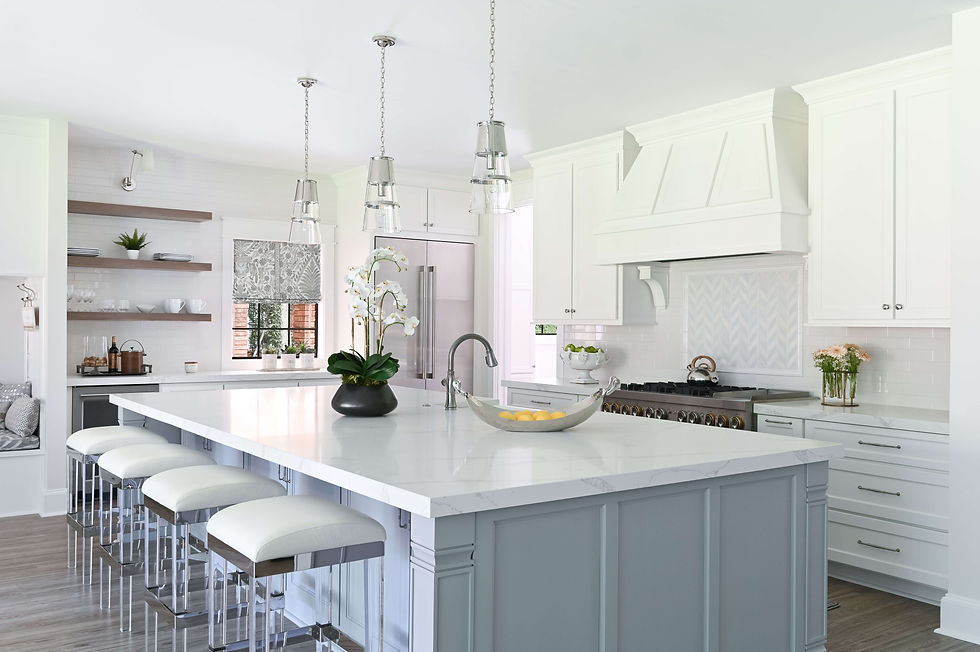When you walk into a beautifully designed kitchen, your eyes are often drawn to the details — the textures of the cabinetry, the gleam of the countertops, the soft glow of the lighting. But one of the most important design elements, both in form and in function, often goes unnoticed until you need it: the range hood.
At Charbonneau Interiors, we view the range hood as so much more than a piece of equipment. It is the heartbeat of the kitchen — working quietly in the background to keep the air fresh while also serving as a powerful design anchor. It’s where engineering meets artistry, and it’s one of the details that can transform a kitchen from simply functional to truly unforgettable.
Why Range Hoods Matter
Imagine preparing a meal for family and friends. Without proper ventilation, the scent of searing steaks or simmering sauces lingers long after dinner ends, and the air feels heavy with smoke or grease. A thoughtfully chosen range hood sweeps all of that away, ensuring the kitchen remains as inviting as it is beautiful. Beyond comfort, ventilation plays a key role in health and safety — especially with gas cooktops, where local codes may require proper ventilation. And from a design perspective? A well-placed hood can become a breathtaking focal point, grounding the kitchen and balancing the space.
Finding the Right Style
Every kitchen tells a story, and the range hood should complement that narrative. For some, a discreet under-cabinet hood keeps the focus on cabinetry and tilework. For others, a bold plaster or copper hood becomes a statement piece, almost sculptural in its presence.
In open-concept homes, a downdraft hood may feel more harmonious, preserving sightlines into living areas. Meanwhile, island hoods can be both dramatic and practical when designed thoughtfully. And for our clients who want something truly one-of-a-kind, we nearly always recommend a custom hood — a design that marries high-performance ventilation with a tailored finish, whether it’s hand-plastered, clad in warm wood, or wrapped in sleek metal.
What to look for in a Range Hood:
Noise Levels: Look for models between 1.0–5.0 sones for a quieter kitchen experience.
Filters: Mesh filters are easy to clean, best for light use. Baffle filters are durable, efficient, and ideal for serious cooks. Charcoal filters are great for ductless models.
Ducted vs. Ductless: Ducted hoods vent outdoors (most effective), while ductless models filter and recirculate air (easier to install).
Function Meets Form
While beauty is paramount, function ensures a kitchen that works as beautifully as it looks. Range hoods are measured by their power, or CFM (cubic feet per minute), which tells us how effectively they clear the air. They should be quiet enough to allow conversation to flow as easily as the wine being poured, and wide enough to capture steam and smoke with ease.
Thoughtful details like dimmable lighting add ambiance, while filters — whether mesh, baffle, or charcoal — keep maintenance simple and efficient.
It’s these quiet functions, often hidden from view, that allow the beauty of the kitchen to shine without compromise.
How to Clean & Care for your Range Hood:
Mesh filters can go in the dishwasher, while baffle filters need degreaser.
Schedule professional duct cleaning every 1–2 years.
Wipe down the hood exterior frequently to prevent grease buildup.
A Detail Worth Designing Around
Just as a piece of art deserves the right frame, a range hood deserves careful attention to scale and placement. Ideally, it should extend slightly wider than the cooktop, sitting at the perfect height to balance performance with proportion. The result is not only functional but visually harmonious, creating rhythm and flow within the kitchen’s architecture.
How to Measure for your Range Hood:
Width: Your range hood should be at least 3 inches wider than your stove on each side.
Height: Typically 24–30 inches above the cooktop for best performance. Higher ceilings may require special mounting solutions.
Trends We Love
Right now, we’re seeing clients gravitate toward two extremes: either minimalist hoods that blend seamlessly into the cabinetry or bold statement hoods that command attention with sculptural curves, plaster finishes, or unexpected materials like stone or hammered metal. Both approaches celebrate the range hood not just as a necessity but as a design opportunity.
Design Trends for Range Hoods:
Minimalist: Slim, discreet designs that nearly disappear.
Commercial-Style: Stainless steel, industrial edges, bold presence.
Statement Hoods: Custom plaster, copper, or wood-clad hoods that double as artwork.
The Investment of a Lifetime Kitchen
Range hoods span a wide range of budgets, from simple, efficient models to fully customized designs integrated into luxury kitchens. Regardless of investment level, the goal is the same: to select a hood that supports the way you cook and the way you live, while also enhancing the overall look and feel of the space. With regular care — like cleaning filters and wiping down surfaces — your range hood will serve you beautifully for years to come.
How to Budget for a Range Hood:
Entry-Level ($300 and under): Best for small kitchens or light cooking.
Mid-Range ($300–$800): Offers stronger performance and quieter operation — great for most homes.
Premium ($800+): High power, whisper-quiet, customizable finishes — the ultimate choice for bespoke kitchens.
Bringing It All Together
At the end of the day, the range hood is both guardian and jewel of the kitchen. It protects the air you breathe, elevates the way you cook, and completes the story your home tells. Whether you dream of a sleek hidden vent or a show-stopping custom hood, our team at Charbonneau Interiors will help you find the perfect blend of form and function, designed just for you.
Our fall calendar is now open, and we would love to help you create the home of your dreams. Let’s work together to design spaces that are as functional as they are beautiful.






%20(4)%20(1).png)










.png)
Comments